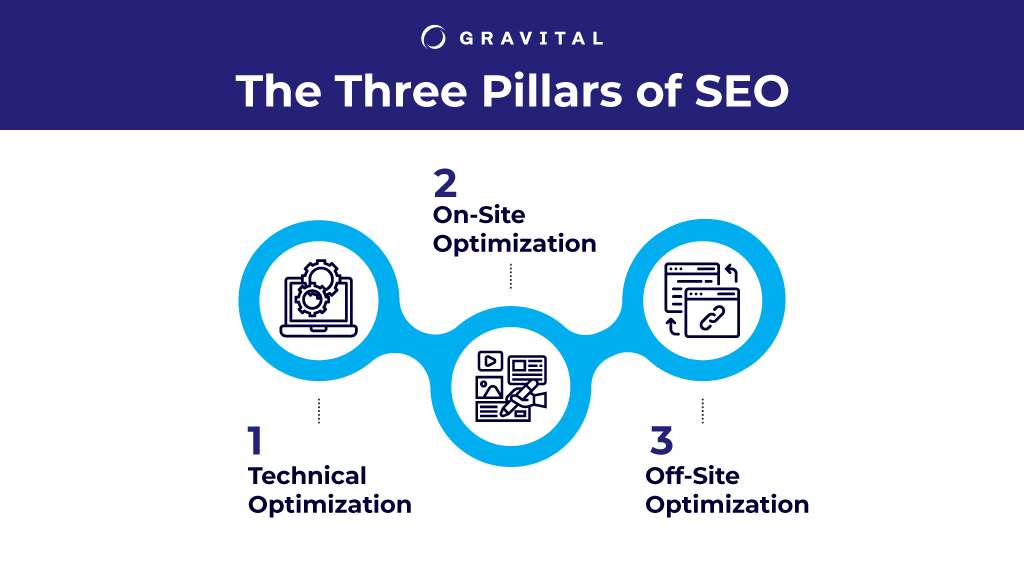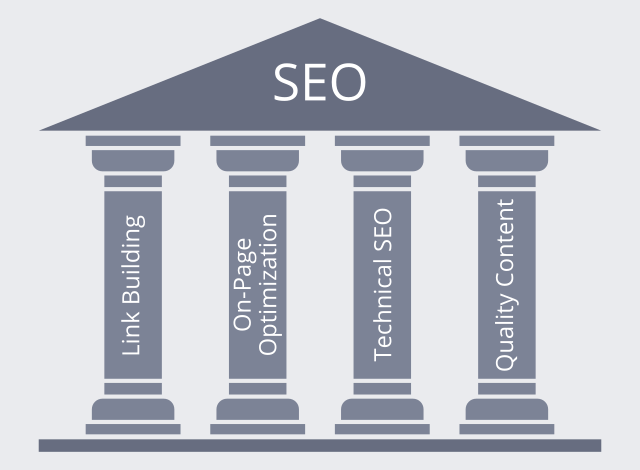Are you feeling overwhelmed by the ever-changing world of SEO? You’re not alone.
Understanding the foundation of search engine optimization can feel like solving a puzzle. But what if you could break it down into clear, manageable pieces? That’s exactly what we’re going to do. By uncovering the pillars of SEO, you’ll gain the insights you need to enhance your website’s visibility and performance.
Imagine the thrill of seeing your site climb the search engine ranks, attracting more visitors, and boosting your business. Intrigued? Keep reading to discover how many pillars of SEO there are and how they can transform your online presence.
Seo Basics
Understanding the basics of SEO can be your ticket to boosting your website’s visibility. It’s not just about keywords; it’s about creating a seamless experience for users and search engines alike. Imagine your website as a storefront — SEO is the signage that draws customers in.
When I first dabbled in SEO, I was overwhelmed by its complexity. But breaking it down into pillars made everything clearer. Have you ever wondered how many pillars hold the foundation of effective SEO?
The Four Pillars Of Seo
SEO is built upon four main pillars: Technical SEO, On-Page SEO, Off-Page SEO, and Content. Each plays a crucial role in how your website performs in search results.
Technical SEO is like the blueprint of your website. It ensures your site is built properly and can be crawled by search engines. Make sure your website has a fast loading speed and mobile-friendly design.
On-Page SEO is the art of optimizing your web pages. It includes using the right keywords and meta tags. Structure your content well, and make sure it’s relevant to what people are searching for.
Why Off-page Seo Matters
Off-Page SEO is all about gaining authority. Think of it as networking — the more your website is mentioned elsewhere, the more credible it becomes. Get backlinks from reputable sites to boost your ranking.
When I noticed my website traffic increase after a few strategic backlinks, I realized the power of off-page SEO. Have you tried building relationships with other websites?
Content: The Heart Of Seo
Content is the driving force of SEO. Quality content answers questions, solves problems, and engages readers. Make your content valuable and relevant to your audience.
Consider this: would you stay on a website that doesn’t provide useful information? Engaging content keeps visitors coming back. What topics are your audience interested in?
Understanding these pillars is crucial for SEO success. Each element complements the others. Are you ready to strengthen the foundation of your SEO strategy?
Technical Seo
Technical SEO is the backbone of your website’s performance on search engines. It’s like setting the stage before the show starts. Without a solid foundation, all your other SEO efforts might crumble. Technical SEO ensures that search engines can easily access, crawl, and understand your site. These elements are crucial for making your website visible and accessible to your audience.
Site Architecture
Think of your website’s architecture as a well-organized library. You want users and search engines to find what they’re looking for effortlessly. A clean, logical structure helps search engines index your pages accurately. Consider using a flat site architecture, where important pages are just a few clicks away from the homepage. This enhances user experience and boosts your chances of ranking higher.
Crawlability
Crawlability is about ensuring search engines can navigate your site effectively. If search engines can’t crawl your pages, they can’t rank them. Use tools like Google Search Console to check for crawl errors. Fixing broken links and creating an XML sitemap can significantly improve your site’s crawlability. Have you checked how easily search engines can explore your site lately?
Mobile Optimization
With more people using smartphones to browse the web, mobile optimization is no longer optional. A mobile-friendly site improves user experience and is favored by search engines. Use responsive design to make sure your site looks great on all devices. Have you tested your site on mobile recently? It might surprise you how different it appears.
Page Speed
Page speed is a critical factor for both SEO and user satisfaction. Slow-loading pages can frustrate users and send them away. Tools like Google PageSpeed Insights can help you identify and fix speed issues. Compressing images and enabling browser caching can make a noticeable difference. How quickly does your site load? If you don’t know, it’s time to find out.
Technical SEO might seem complex, but focusing on these key areas can dramatically improve your site’s performance. Start by assessing your site architecture, ensuring crawlability, optimizing for mobile, and boosting page speed. Each step you take not only helps search engines but also enhances the experience for your users. So, are you ready to give your website the technical boost it needs?
On-page Seo
On-page SEO is one of the three pillars of SEO. It focuses on optimizing individual web pages. This includes using relevant keywords, improving content, and enhancing user experience.
Understanding On-Page SEO is crucial for anyone looking to improve their website’s visibility in search engine results. This pillar focuses on optimizing individual web pages to rank higher and earn more relevant traffic. By refining elements like content and HTML source code, you can significantly enhance your site’s SEO performance. Let’s dive into some key components of On-Page SEO.Keyword Research
Keyword research is the foundation of On-Page SEO. It involves identifying and targeting the words and phrases your audience uses when searching for products or services like yours. Using tools like Google Keyword Planner can provide insights into search volume and competition. Imagine having a shop in a crowded market; you need to know what your customers are asking for to stock the right goods. Similarly, choosing the right keywords ensures you’re meeting your audience’s needs.Meta Tags
Meta tags are snippets of text that describe a page’s content. They don’t appear on the page itself but in the page’s code and help search engines understand what the page is about. Think of meta tags as a book’s blurb. It gives potential readers (or search engines) a quick overview, encouraging them to delve deeper. Make sure your meta tags are concise, relevant, and include keywords for better SEO results.Content Quality
Content is king in the world of SEO. High-quality content that provides value to users is more likely to rank well. Aim to create engaging, informative, and original content that answers questions or solves problems for your audience. Consider your personal experience reading a blog that captured your attention from start to finish. The engaging narrative and valuable insights kept you hooked, didn’t it? Strive to offer that same experience to your readers.Internal Linking
Internal linking refers to the practice of linking to other pages within your website. This helps search engines understand the structure of your site and establishes a hierarchy. It’s like creating a roadmap for both users and search engines. By guiding visitors to related content, you keep them engaged longer and improve your site’s SEO. Have you ever clicked on a link within an article that led you to more valuable information? That’s internal linking doing its job effectively. These elements of On-Page SEO are not just technical necessities but also an opportunity to connect more deeply with your audience. Which aspect of On-Page SEO will you focus on first to boost your website’s performance?Off-page Seo
Off-Page SEO is crucial for improving website visibility and authority. It focuses on external factors that influence search engine rankings. By enhancing off-page elements, websites can gain credibility and drive organic traffic.
Backlink Building
Backlinks are links from other websites to yours. They act as votes of confidence. Quality backlinks boost your site’s authority and search engine ranking. Aim for backlinks from reputable sites. Avoid low-quality or spammy links. Diverse backlinks make your profile strong. Focus on gaining links naturally.
Social Signals
Social signals refer to engagement on social media platforms. Likes, shares, and comments impact your site’s visibility. High engagement signals popularity to search engines. Active social media presence increases brand awareness. Encourage users to share your content. Respond to comments to boost engagement.
Brand Mentions
Brand mentions are references to your brand online. They don’t have to be linked. Search engines notice these mentions. Positive mentions enhance your site’s credibility. Monitor mentions using tools. Engage with those talking about your brand. Foster positive online reputation. Mentions contribute to authority building.
User Experience
Understanding user experience is crucial in SEO. A good user experience keeps visitors on your site longer. It also reduces bounce rates. It can improve your search rankings too. Focus on making your site easy to use and navigate. Let’s delve into the aspects of user experience.
Page Layout
A clean page layout enhances user experience. It should be simple and organized. Avoid cluttering your page with too many elements. Use whitespace to make your content stand out. This helps users focus on what’s important. A well-structured layout guides users through your site smoothly.
Readability
Readable content keeps users engaged. Use short sentences and simple words. Break your text into small paragraphs. This makes it easier to read. Use headings and subheadings to organize content. They help users find information quickly. Clear and concise content improves understanding and retention.
Navigation
Easy navigation is essential for a good user experience. Make sure your menu is visible and accessible. Use clear labels for your navigation links. This helps users find what they need effortlessly. Include a search bar for quick access. Simple navigation keeps users on your site longer and encourages exploration.

Credit: www.semrush.com
Content Strategy
Understanding the pillars of SEO is crucial for developing an effective content strategy. SEO has three main pillars: on-page optimization, technical SEO, and off-page SEO. Each pillar plays a vital role in enhancing visibility and driving traffic to your website.
In the realm of SEO, the importance of a robust content strategy cannot be overstated. A well-crafted content strategy guides your website’s voice, attracting and retaining visitors while boosting your search engine rankings. It’s about understanding what your audience craves and delivering it consistently. But how do you make sure your content strategy stands out? Let’s break it down.Content Planning
Effective content planning is the backbone of your strategy. It involves knowing your audience and anticipating their needs. Start by identifying key topics that resonate with them. Use keyword research tools to pinpoint popular search terms. This ensures your content aligns with what people are actively looking for. Consider creating a content calendar. It helps you stay organized and ensures regular updates to keep your audience engaged.Content Distribution
Once you’ve crafted your content, the next step is distribution. Think of it as making sure your voice is heard. Social media platforms, email newsletters, and guest blogging are powerful avenues. Have you ever shared a blog post only to find it gaining traction through shares? That’s the power of distribution. Engage with your audience across different platforms to expand your reach. Remember, the more places your content appears, the more visibility you gain.Content Updates
Content updates are crucial for maintaining relevance. The digital world is constantly evolving, and your content should too. Regular updates ensure your content stays accurate and fresh. Have you ever landed on a blog post only to find outdated information? It can be frustrating. Avoid this by revisiting old posts and refreshing them with new insights. This not only enhances the user experience but also signals to search engines that your site is active and reliable. How do you plan to keep your content strategy vibrant and impactful? The key lies in understanding your audience, sharing widely, and staying current.Local Seo
Local SEO is a crucial component of your digital marketing strategy if you want to attract customers in your area. Whether you own a cozy coffee shop or a bustling hardware store, optimizing for local search can make all the difference. It’s all about making sure people nearby can find your business easily when searching online. Let’s dive into some key elements of Local SEO.
Google My Business
Google My Business (GMB) is your business’s digital storefront. Imagine someone searching for a service you offer in their neighborhood, and your business pops up with all the essential details. You should ensure your GMB profile is complete and accurate. Add a compelling description, your business hours, and contact details. Don’t forget photos of your products or services. Have you ever searched for a restaurant and felt drawn to it because of its enticing photos? That’s the power of visual appeal.
Local Citations
Local citations are mentions of your business on the web, like directories. They often include your name, address, and phone number. Consistency is key here. Ensure your information is uniform across all platforms. Ever tried calling a business only to find their number was incorrect? Frustrating, right? This mistake can cost you potential customers. Use tools to manage these listings and keep your information updated.
Reviews Management
Reviews can make or break your business. Positive reviews build trust and attract more customers. Encourage satisfied customers to leave reviews. Responding to reviews shows you value your customers’ feedback. Have you ever been swayed by glowing reviews when choosing between two similar services? Your potential customers do the same. Address negative reviews constructively to demonstrate your commitment to improving.
Local SEO is not just an option; it’s a necessity for businesses wanting to thrive in their community. Are you ready to make your business the go-to choice for locals?

Credit: highlevelmarketing.com
Evolving Seo Trends
SEO has three main pillars: technical SEO, on-page SEO, and off-page SEO. These pillars guide strategies for better search rankings. Understanding each helps improve website visibility.
The world of SEO is always changing. New trends and technologies shape the way we optimize websites. These changes can make SEO more effective. Let’s explore some key evolving trends in SEO.Voice Search
Voice search is growing fast. More people use smart speakers and voice assistants. This trend changes how we think about keywords. Long-tail keywords are more common in voice searches. People ask questions differently when speaking. They use full sentences and natural language. Optimizing for voice search means understanding these differences. It’s about making content that answers questions clearly.Ai And Machine Learning
AI and machine learning are powerful tools in SEO. They help search engines understand content better. These technologies analyze user behavior. They predict what users might want next. This means SEO strategies must be more dynamic. Content should be relevant and engaging. AI can also help with content creation. It suggests topics and keywords based on data.Video Seo
Video content is on the rise. More users prefer watching videos over reading text. Search engines are adapting to this shift. Optimizing video content is crucial. Use descriptive titles and tags. Include transcripts for better accessibility. Video thumbnails should be eye-catching. Videos should load quickly and be mobile-friendly. Engaging video content can boost rankings. It keeps users on your site longer.
Credit: gravitalagency.com
Frequently Asked Questions
What Are The 4 Pillars Of Seo?
The four pillars of SEO are technical SEO, on-page SEO, off-page SEO, and content. Technical SEO enhances website structure. On-page SEO focuses on optimizing individual pages. Off-page SEO involves building backlinks. Content creation ensures valuable and relevant information for users.
Together, these pillars improve search engine rankings.
What Are 3 Pillars Of Seo?
The three pillars of SEO are on-page SEO, off-page SEO, and technical SEO. On-page focuses on optimizing content and keywords. Off-page involves building backlinks and authority. Technical SEO improves site speed, mobile-friendliness, and crawlability. These elements enhance search engine visibility and user experience.
What Are The 4 P’s Of Seo?
The 4 P’s of SEO are Product, Price, Place, and Promotion. Product involves content quality. Price refers to the investment in SEO strategies. Place covers website optimization and mobile-friendliness. Promotion includes link-building and social media engagement. These elements enhance visibility and drive organic traffic.
What Are The 4 Types Of Seo?
The four types of SEO are On-Page SEO, Off-Page SEO, Technical SEO, and Local SEO. On-Page SEO focuses on optimizing individual web pages. Off-Page SEO involves external factors like backlinks. Technical SEO ensures a website’s infrastructure supports search engines. Local SEO targets local search results.
Conclusion
Understanding SEO pillars is crucial for online success. Each pillar plays a vital role. Boost your site’s visibility. Ensure your content is relevant and engaging. Optimize technical aspects for better performance. Build trustworthy links to increase authority. Analyze data to refine strategies.
These pillars work together to enhance your site’s presence. Stay informed and adaptable. SEO is dynamic and requires continuous learning. Implement these strategies effectively. Your website will benefit greatly. Success comes from a balanced approach. Keep improving and watch your site’s growth.
Embrace the pillars, and elevate your SEO game.




